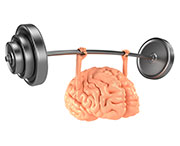Dementia, one of the most debilitating diseases of humankind, is increasing in global prevalence with over 50 million patients.1-3 Dementia is a general term that describes the loss of cognitive ability, social functioning, and memory. There are many disease states that cause dementia representing divergent pathophysiologies, which are complex, multifactorial, ever-changing and not fully characterized.
Alzheimer’s is the most common neurodegenerative disease representing 60-70 percent of all dementia cases with an approximate 5.5 million patient prevalence rate in the U.S. and greater than 43 million patients globally.1-3 One in 10 seniors in the U.S. older than 65 have Alzheimer’s disease,1-3 yet interestingly, only one in four patients with Alzheimer’s disease have been diagnosed.1-3
The percentages of the U.S. population with Alzheimer’s by age are 85+ years, 38 percent; 75-84 years, 44 percent; 65-74 years, 15 percent; <65 years, 4 percent.1-3 Vascular dementia and Lewy body dementia are the next two most prevalent neurodegenerative diseases representing approximately 15-25 percent of dementia cases each.1-3 Parkinson’s disease-related dementia and frontotemporal dementia represent the next two most common neurodegenerative disease states, and each maintains single-digit prevalence rates.1-3
Sadly, Alzheimer’s disease is the sixth leading cause of death in the U.S., killing more people than breast cancer and prostate cancer combined1-3 with cases growing; an 89 percent increase in the Alzheimer’s death rate was documented between 2004 and 2017.1-3
The costs to individuals and our economy are significant. The total lifetime cost of care for a patient with dementia in the U.S. in 2018 was estimated greater than $250,000.1-3 It is estimated that Alzheimer’s disease and other dementias cost the U.S. $305 billion annually, which is projected to increase to $1.1 trillion by 2050.1-3
Though there are many promising ongoing dementia clinical trials using immunotherapy, to date, there have been no FDA-approved disease-modifying agents that have significantly altered the trajectory of decline due to the onslaught of neurodegenerative disease.4
However, there is something we can all do to help reduce dementia risk and lessen cognitive impairment. Indeed, this is something that is supported by a growing compendium of medical research. It’s something we all know we should be doing anyway; that’s right, it’s getting regular exercise. Specifically, more and more medical research has shown that aerobic exercise can reduce dementia risk and cognitive impairment.4
Recently, there have been meta-analyses of prospective clinical trials that have demonstrated a significant reduction in the risk of dementia in those who maintain routine exercise regimens in midlife.4 Moreover, patients already diagnosed with mild cognitive impairment or even dementia tested for higher cognitive scores after maintaining a regular exercise schedule for six–12 months when compared to inactive controls.4
Interestingly, several other prospective clinical trials demonstrated increased cognitive ability in healthy patients who regularly exercised when compared to sedentary individuals.4 Randomized control clinical trials have documented statistically significant increases in brain volume and neural connectivity using advanced radiology imaging studies such as MRI brain volumetry analysis.4 Furthermore, medical literature has shown regular exercise helps patients with Parkinson’s disease and multiple sclerosis.5,6
In summary, the medical literature supports the use of exercise in reducing dementia risk, growing brain volume, increasing neural connectivity, and elevating cognitive ability in all people, including healthy patients, those with mild cognitive impairment, and even in patients with clinical dementia. Regular exercise should therefore be on all of our routine to-do lists.
Dr. Hancock is a board certified neuroradiologist with Halo Diagnostics and can be reached at (760) 694.9559. He is also a member of Desert Doctors. For more information, visit www.HaloDX.com or www.DesertDoctors.org.
References:
1) https://www.alz.org/alzheimers-dementia/facts-figures;
2) https://www.cdc.gov/nchs/pressroom/sosmap/alzheimers_mortality/alzheimers_disease.htm;
3) https://www.alz.co.uk/research/world-report;
4) https://doi.org/10.4065/mcp.2011.0252;
5) https://www.nature.com/articles/s41582-020-0355-1?proof=t;
6) https://www.sciencedaily.com/releases/2019/03/190304105418.htm













































Comments (0)